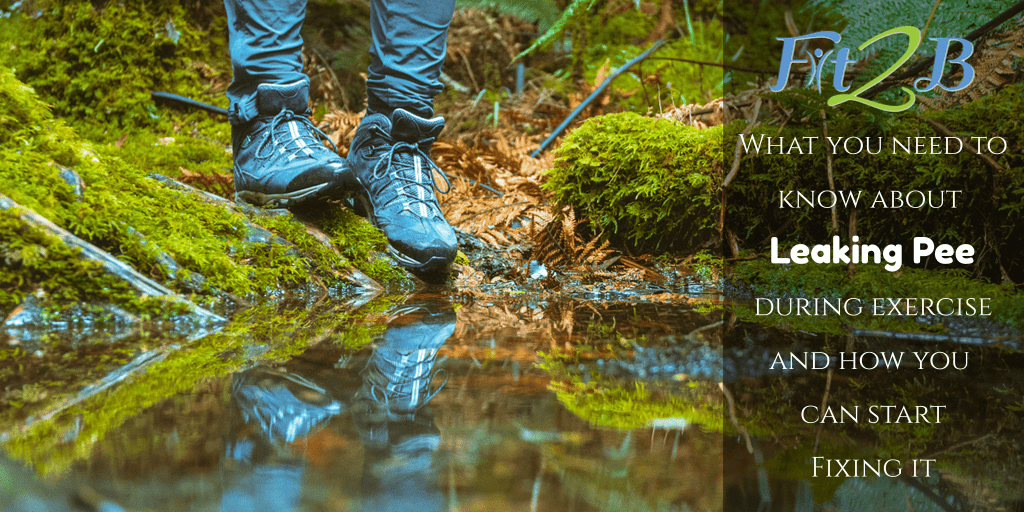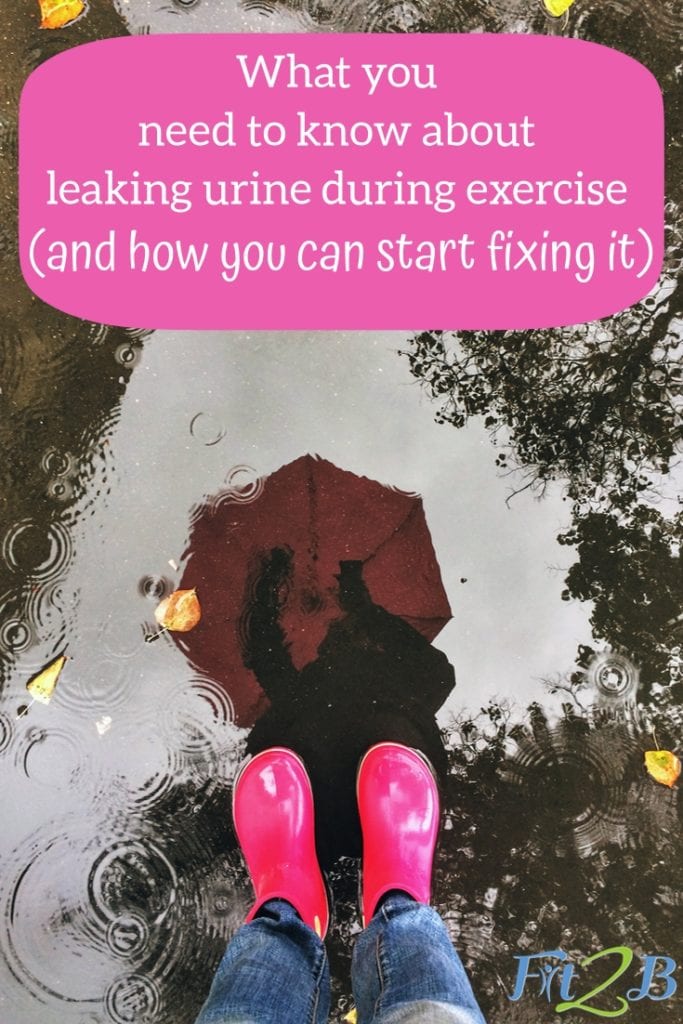Blog
Leaking Urine During {or After} Exercise Isn’t “Normal”
 Do you or someone you know have issues with incontinence during daily life activities? Then this post is for you. There is hope, friends.
Do you or someone you know have issues with incontinence during daily life activities? Then this post is for you. There is hope, friends.
Just because it’s common for women who’ve had children to leak some pee when they cough, laugh hard, make love, or jog to catch up with a runaway toddler, THAT DOES NOT MEAN THAT LEAKING URINE IS NORMAL or acceptable. “Common” does not equal “normal.” I refuse to accept what is common if it is damaging me.
When I was pregnant with my first, I was told to expect leaking and accept it. I was told to laugh it off. After all, it’s part of having kids, right? It’s part of training hard even if you don’t have kids. Or is it?
Wait, I’m not saying you’re “abnormal” and unfixable if you’re sneeze-peeing or dribbling when you deadlift. The “normal” I’m referring to is a standard of quality of life. Yeah, usually normal is just a setting on the dryer, but in physical and medical terms, we cannot let ourselves be duped into welcoming sub-standard as “normal.”
However, powerful organizations do it all the time. CrossFit even went so far as to encourage Exercise Induced Urinary Leakage (EIUL) and boast about it {watch the video below yourself} perhaps in their attempt to make light of it. But I am here to tell you that your exercise program can and should IMPROVE your incontinence issues, not make them worse.
If you watched that video clip, what did you think of the gynecologist who damned all of us to the normalcy of peeing, saying she has trouble too? Shouldn’t she know — even better than me — how those muscles function and how to fix them? What about when she said someone should invent something? Ha! For me, the first time I watched it, I was yelling at my screen that “God already did make something! It’s called your pelvic floor muscles, only you broke them!”
Ahem. Obviously I’m not the one to calmly respond when I see nutso-ness like this, so I’m very grateful for professionals much more educated {and calm} on the topic than myself like Pelvic Guru who wrote this open response letter to CrossFit {click to read} about that awful video, and I’m happy to report there has been some connections made since then.
“It’s the little things! I’ve never had a serious problem, but the last time I played on a trampoline I had to stop pretty quickly. Today I took the kids to Pump It Up, which is one of those big warehouses full of bouncy castles. I was able to jump with them — even jump holding my almost 2-year-old — with no fear of incontinence. Very cool!” —Annette C.
Now that quote from a Fit2B member is awesome!!! If your pelvic floor (PF) happens to give you any issues after the fact (like in the days following a strenuous workout) you need to take a step back and analyze what you did. Refocus on your core and alignment, double back, assess how you can approach your goal from a lower-impact or less-pressure angle, and consider seeing a qualified specialist who eats, sleeps, and breathes core and pelvic floor health.
 Some research on incontinence
Some research on incontinence
- According to this research by Ereckson et al published in Female Pelvic Medicine & Reconstructive Surgery, ladies who leak move differently. The abstract went as far as saying that leaking leaves us functionally disabled! Functional dependence or disability with any activities of daily living was reported in 62.1% (95% CI, 54.2%–70.1%) of women with daily urinary incontinence.
- This study by Spitznagle et al reported a relationship between the presence of diastasis rectus abdominus (DRA) and pelvic floor dysfunction. “Patients with DRA were older, reported higher gravity and parity, and had weaker pelvic floor muscles than patients without DRA. Sixty-six percent of all the patients with DRA had at least one support-related pelvic floor dysfunction (SPFD) diagnosis.”
- Listen to our Fit2B Radio Podcast Episode 44: The One With All The Research to learn more about recent studies on the core and female incontinence.
 Let me get really personal …
Let me get really personal …
Sometimes when I push myself a little too hard too fast, doing something that wears me out, my PF acts tired for a couple days afterward. Less so the longer I am at this and the stronger my own own PF gets.
For example, I’ve been adding box jumps to my routine once a week. When I first did them, I only did 5 or 6 onto a small block, and they felt good, no leaking. So the next time, I was dumb and did two sets of 12 jumps up onto a medium block. Yeah. No. I leaked every so often for the next week. I didn’t give up, but I backed off and re-approached it. Focused on my Mula Bandha skillz for a couple weeks, then went back to the block more conscious of purposefully activating and did one set of 8. That was about right. I’m up to two sets of 8–10 without issues now.
But I would not be there if I had pushed.
If I had bought the lie that peeing is a sign of pushing hard, and it’s okay to leak, and that wetting myself is somehow a gold standard of strength, I would be a wreck and quite smelly right now! How can I expect to teach all of you about your cores if mine is messed up?
My diastasis recti is totally closed {click to read my initial story} and I do not leak anymore … unless I push too hard, and then I back off and re-approach. I’ve consulted Kelly Dean many times when this happens, since she’s my go-to PT.
Leaking isn’t an inconvenience to be ignored. It’s insight to consider and evaluate!
According to physical therapist Julie Wiebe of Interior Fitness, “The pelvic floor partners with the diaphragm and TA specifically, and a host of other muscular relationships collectively to accomplish pelvic health.” Julie guest blogged a highly informative three-part series on the pelvic floor for Pregnancy Exercise who happens to be one of our “Experts on Diastasis Recti” ecourse contributors! I’m proud to say that our fitness programs here at Fit2B line up nicely with both of those lovely ladies. 😉
“Fitness should reinforce the central stability system (more commonly known as the ‘core’), and actually be positive and protective. The central stability system and the continence system are one and the same. The issue is that mums don’t automatically restore that system after childbirth and their fitness programs strengthen the compensations they have developed instead. {Fit2B addresses compensations}
“For example, the pelvic floor can strengthen right along with the other muscles in a fitness program particularly when integrated. {Fit2B integrates the pelvic floor with core work in our Mula Bandha and Pelvic Floor Connections routines plus cues for the PF in many other routines as well} But if their program doesn’t encourage a balance of muscle work {unlike Fit2B} such as an over focus on abdominals, without balancing work on muscles of the back and bum, the system can get out of balance. This could manifest as a leak, but it could also show up as a hip, low back, or knee issue … Once balance is restored, then build your fitness on that foundation” {just like our Foundational Five routines where we start each new member}. —Julie Wiebe, PT
{Disclaimer: Everything inside pretty parentheses in that last quote by Julie was my wording, not Julie’s}
Kelly Dean said, “In our practice we find that about 70-80% of pelvic floor issues are mostly resolved with core rehab and pelvic alignment training. … When the core is weak we tend to tuck our tail to stabilize our pelvis. The tilted pelvis and weak core allows everything to rest too low and ultimately bulge low. When you can, core work in standing with focus on neutral pelvis and long lean and lifted is key. … This is the beginning of everything we do. When your core is strong and your pelvis is neutral things will look different. Also watch how you are holding/wearing the baby. … Most carriers cause us to tuck our tail and put pressure down in our pelvic floor. it is hard to fix a problem that is constantly being made worse.”
“I just finished the new pelvic floor routine. BEAUTIFULLY done, Beth Learn!! I wish I could send this to most of my former coworkers who often laughed until they leaked and then laughed about leaking. I am thankful that is not a club I will need to join.” —Lindsey H.
So, let me be clear about whether core rehabilitation and tummysafe fitness can really TRULY definitely help with pelvic floor issues. The answer is a resounding yes!
Once again, I wish to remind everyone that Fit2B is your core-aware fitness partner that you should ideally utilize AFTER you do rehab with a licensed professional who specializes in diastasis recti and pelvic floor trauma, preferably one-on-one — but if you can’t find a good one in your area then THIS PROGRAM with neuromuscular physical therapist Kelly Dean of The Tummy Team is my favorite online ab rehab.
This same concept of being unable to truly move forward until we heal what is broken can be seen in this story from a Fit2B member who reminds us that taking a step back to fix our foundations isn’t regressing if it’s what our bodies need …
“I’m 8 months pp with my 2nd. I am a personal trainer and love more intense workouts but I kept undoing any progress I had made on my 3 finger dr by doing an intense workout. I finally bit the bullet and stopped any high impact moves, all moves that require twisting, and all moves in a prone position. I also started wearing my brace around the house and to bed to remind myself to stay engaged. I am sticking to the F5 and beginning pathways exercise and still lift a bit at the gym but I am finally making progress (down to 2 finger in 2 weeks). It’s hard to slow it down when you are used to going harder, but we need to give our bodies time to heal so we don’t do more harm.” —Brenda H.
 Four years ago, I was in Brenda’s same shoes: personal training, leading group workouts, etc. Slowing down was the BEST thing I ever did. Writing down what I did and how I slowed down was the next best thing because here we all are on Fit2B 😉
Four years ago, I was in Brenda’s same shoes: personal training, leading group workouts, etc. Slowing down was the BEST thing I ever did. Writing down what I did and how I slowed down was the next best thing because here we all are on Fit2B 😉
You cannot take care of others until you take care of yourself. Once you know how to fix yourself THEN you are truly qualified to help others, even if you are still on your journey.
“I made the big mistake of strengthening my TA way more than my PF before getting pregnant. I ignored engaging both and taking things slowly enough for both to strengthen at the same rate. So just keep up the mula bandha and learning your body.” —Catie W.
“I closed my DR between weeks 24-28 through watching my alignment and also doing about 1 video a day or so. (I had 3 under 3 at the time I was pregnant, so it was hit or miss!) Also, if you don’t already practice propping up your feet while on the toilet, I found that to be tremendously helpful. You can buy the squatty potty stool, or use a kids’ step stool. The goal is to relax your pelvic floor while engaging your transverse, the same motions needed for correct pushing.” —Bethann W.
“I really dislike when women think it is normal to start peeing your pants as you age or after you have children. It might be common, but that does not make it normal or something to just accept. The positive thing about normalizing things like this is that women feel like they can talk about it, but the downside is that when it is ‘normal’ there is no need to see help or solutions.” —Christine G.
Another logical point that Kelly Dean of The Tummy Team has made about the pelvic floor is this: If you leak or have things falling out when just standing or walking, then you have no business jumping. Test your body by gradually adding more load/impact while you maintain a “mula bandha” muscle action of your PF. The move that fatigues your ability to hold in split seconds, that is your new area to work on. If you can barely manage to engage your pelvic floor and transverse abs on an exhale while just standing still, then how will you pull it off while running, let alone jumping on a trampoline?
Quick BIG thing that bugs me: A few programs out there that lead people to believe they can’t move if they have diastasis recti or that they will NEVER be able to do situps again. Nope. NO! Life doesn’t stop while you’re healing, and Fit2B exists to teach you how to keep moving safely while you’re working on thickening your abdominal fascia and bringing the two sides of your abs closer together and KEEPING it fixed. I’m not a fan of situps, but sometimes we have to do a few or twenty …
“Okay, I know sit ups are verboten but I just wanted to say that I can finally do them w/out leaking. Thanks Fit2b!! I have a required fitness test that includes sit-ups, but only 5 more years and then no more sit ups.” —Mary E.
It’s possible to over-focus on the TA and ignore the PF. For me, initial TA-focused ab rehab was enough to resolve all my leaking issues at that time without focusing on my PF at all. While those with pelvic floor issues will often need to focus directly on their PF with special techniques and/or therapy with a qualified specialist, because of how the PF and TA co-activate, many {not all} are able to regain bladder control just from a totally transverse focus:
“I have to say again how much I LOVE Fit2b!!! Yesterday was our homeschool groups Valentine’s party. It was at a Bouncy place w/ all the inflatable slides. I was able to climb and bounce with my kids and keep my tummy tight! *grin emoji* NO LEAKING either! This would have never happened before! I also woke up this morning feeling great w/o being sore! Whoo Hoo!” —Sarah K.
Bottom line {pun intended} I’m so glad there are more resources leaking out {another terrible pun} that teach women to pursue a healthy pelvic floor and so we can ENJOY intimacy and say YES to so many more things!
So … I linked to a LOT of resources in this article, and I will be going back and adding more as I find more and learn more. The human body is intricate and fabulous and confusing and thrilling, and I’ve never tired of researching how it works since I picked up my first book on human anatomy at age 6 … yep! And it was a book about birth! 😉
BIG TAKEAWAY: We don’t have to accept leakage!
We don’t want to be dependent! We don’t want to be disabled!
So why are we laughing about this and telling the next generation to expect the same? No more. Not my daughter. Not your daughter. I refuse to be silent on this issue and sentence my friends and family to a lower quality of life when I know how to help you.
If you have trouble with this, I have several routines on Fit2b.com to help you, including Pelvic Floor Connections, Mula Bandha, Totally Transverse, Restorative Poses and more! Please give them a try and please look into personal physical therapy for yourself soon if you’re dealing with this!


Hi,
I’m trying to wade through all the information out there about Diastasis Recti and how to restore core strength/flatten belly post-baby. I stumbled upon this article, which touched a nerve. When I got back into running 1 year after my daughter was born, I would pee the entire time and had to wear a heavy pad to be able to continue without stopping (pee breaks didn’t even help.) I now leak a little when I cough or sneeze, or if I wait too long to get to the bathroom. I was going through the process of trying to accept that this would just be the way it is for me for the rest of my life, and I would just have to deal with it, but this article gives me a little hope.
The problem is that I’m having trouble finding the relevant information on this page to help me reverse my leakage. There are so many links buried within the article. Is there anywhere you summed it up with a list of links or steps to take to heal this?
I’m currently 15 weeks and I’m trying to figure out what exercises/programs would suit me best. I was originally trying to decide between Tupler Technique and Dia Method, but then Mutu made me question whether those programs were effective (but Mutu didn’t offer a prenatal option.) Now I’m so lost about what direction to go in that I feel like I might be better off doing nothing that choosing the wrong program that could possibly do me more harm than good and cost me $100 or more. Help?
You know what? You’re totally right! I didn’t make that very clear! It sounds like you’re currently pregnant since you mentioned needing a prenatal program. If that’s so, I highly recommend you do Prenatal Core Training with The Tummy Team (click) but if that’s too spendy for you, you should at least go through our Experts on DR course which you can find in our shop here on Fit2B. That course has helped hundreds know what their next step is. I’d say that if you’re pregnant, your next step is nurturing your pelvic floor to minimize your leaking and prepare for birth which will shorten your recovery after you have your baby. I know $100 can feel like a lot, but you’re worth it. If you told a guy he could pay $100 to stop peeing his pants and get a stronger core, he’d lay the cash down! We women struggle with our worth way too much! Imagine running again without leaking!!! The Tummy Team’s program is full on rehab, more basic than fitness, and it requires some slowing down BUT IT WORKS!!! Then Fit2B is the fitness piece that eases you back into DR-aware motions and running when you’re ready. We’ve got your back 🙂
Ahhh! And I went in to fix it and then my computer shut down and didn’t save my changes 🙁 I’ll be trying again later. Thanks for the nudge.
Lovely article guys. I got to hear of you through Nicole Eastman as I am on Grand Cayman. I am a pilates teacher specializing in women’s health. It sounds like we have all reached the same conclusions on DR and PF health which is so reassuring, a holistic alignment based approach, working from the base up that doesn’t forbid certain exercises forever. I’m actual trying to reach out to my local Crossfitters re: that video as we speak to try and come to one of their forums and talk on this issue! Wish me luck! Lx
Oh definitely hope you have success in connecting with CrossFitters! I’m so excited you found me, and if you need anything or want to collaborate, just give me a holler!
I’ve read this article with great interest as it hits so very close to home with me. I am an almost 50 year old woman who has been physically active (including aerobics, kickboxing, and boot camp workouts). I suffer from leakage as well as recently devleoped a pooch. I don’t know whether to jump right into the Fit2B to get the help I need or you mentioned the Core Foundations online rehab. I don’t have the money for both. Can I join Fit2B without doing the online rehab? (I live in a very remote area, so getting help in a more personal way isn’t an option right now.) I desperately want to strengthen my core as well as my pelvic floor.
Also, will this mean no aerobics, etc. until everything is “righted”?
Thank you in advance for any help or insight you can offer.
Anne, you could totally start Fit2B and do it for a few months, and it may help a lot without your needing rehab BUT if there is deep dysfunction, you may require some internal pelvic floor work with a specialist one-on-one. It’s not as scary as it sounds. It’s not that you can’t do cardio. Fit2B has quite a few cardio routines. We just like to start everyone with our basics for the first couple of weeks. That “back to basics” often sheds light on weak spots and helps rebuild your core foundation. Then you slowly ease into our harder routines with that new awareness. Then after 6-8 months, many go back to their prior modes of fitness, knowing how to modify, how to engage their core and pelvic floor correctly, and Fit2B has done its job once more! I hope you join!
I am so curious as to whether starting fit 2 be is worth my while DURING pregnancy or should I wait until after. I am 20 weeks with baby #2 and I had a 2.5-3 finger DR with baby # 1 that probably healed minimally.
I forgot to mention that the babies will be born 26 months apart. I do have the lower abdomen “pooch” that never went away, as well as a weak core, occasional back pain and some urinary incontinence.
You spoke at our MOPS group and it was so encouraging! At the time I was pretty newly post partum and not ready to start regular exercise again, but I have been walking around realigning ever since. Regarding this super embarrassing topic…what about leaking ONLY when you stand up after urinating? I can trampoline, run, no problem, but it’s really getting me down to have this small leak every time I use the toilet. I can’t find any info out there for this. Thank you…
Pingback: What Your Placenta Has To Do With Resting As A New Mom - The Grace Bond
I was curious to read the source article in this bit at the last ” According to this research {click} ladies who leak move differently,” but the link didn’t work. :/ Any chance you can find that material again?
Ronda, I am searching for it. Thanks for letting us know the link is broken!
Pingback: Announcing NEW TummySafe Fit Pro CEU course! | Fit2B Studio
Pingback: Diastasis Recti and Sex: What to Consider | Fit2B Studio